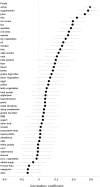Identification of 102 Correlations between Serum Metabolites and Habitual Diet in a Metabolomics Study of the Prostate, Lung, Colorectal, and Ovarian Cancer Trial
- PMID: 31848620
- PMCID: PMC7138659
- DOI: 10.1093/jn/nxz300
Identification of 102 Correlations between Serum Metabolites and Habitual Diet in a Metabolomics Study of the Prostate, Lung, Colorectal, and Ovarian Cancer Trial
Abstract
Background: Metabolomics has proven useful for detecting objective biomarkers of diet that may help to improve dietary measurement. Studies to date, however, have focused on a relatively narrow set of lipid classes.
Objective: The aim of this study was to uncover candidate dietary biomarkers by identifying serum metabolites correlated with self-reported diet, particularly metabolites in underinvestigated lipid classes, e.g. triglycerides and plasmalogens.
Methods: We assessed dietary questionnaire data and serum metabolite correlations from 491 male and female participants aged 55-75 y in an exploratory cross-sectional study within the Prostate, Lung, Colorectal, and Ovarian Cancer Screening Trial (PLCO). Self-reported intake was categorized into 50 foods, food groups, beverages, and supplements. We examined 522 identified metabolites using 2 metabolomics platforms (Broad Institute and Massachusetts General Hospital). Correlations were identified using partial Pearson's correlations adjusted for age, sex, BMI, smoking status, study site, and total energy intake [Bonferroni-corrected level of 0.05/(50 × 522) = 1.9 × 10-6]. We assessed prediction of dietary intake by multiple-metabolite linear models with the use of 10-fold crossvalidation least absolute shrinkage and selection operator (LASSO) regression.
Results: Eighteen foods, beverages, and supplements were correlated with ≥1 serum metabolite at the Bonferroni-corrected significance threshold, for a total of 102 correlations. Of these, only 5 have been reported previously, to our knowledge. Our strongest correlations were between citrus and proline betaine (r = 0.55), supplements and pantothenic acid (r = 0.46), and fish and C40:9 phosphatidylcholine (PC) (r = 0.35). The multivariate analysis similarly found reasonably large correlations between metabolite profiles and citrus (r = 0.59), supplements (r = 0.57), and fish (r = 0.44).
Conclusions: Our study of PLCO participants identified many novel food-metabolite associations and replicated 5 previous associations. These candidate biomarkers of diet may help to complement measures of self-reported diet in nutritional epidemiology studies, though further validation work is still needed.
Keywords: biomarkers; dietary questionnaire; food; metabolites; metabolomics.
Published by Oxford University Press on behalf of the American Society for Nutrition 2019.
Figures


References
-
- Bingham SA, Luben R, Welch A, Wareham N, Khaw KT, Day N. Are imprecise methods obscuring a relation between fat and breast cancer?. Lancet. 2003;362(9379):212–4. - PubMed
-
- Johansson L, Solvoll K, Bjorneboe GE, Drevon CA. Under- and overreporting of energy intake related to weight status and lifestyle in a nationwide sample. Am J Clin Nutr. 1998;68(2):266–74. - PubMed
-
- Neuhouser ML, Tinker L, Shaw PA, Schoeller D, Bingham SA, Horn LV, Beresford SA, Caan B, Thomson C, Satterfield S et al. .. Use of recovery biomarkers to calibrate nutrient consumption self-reports in the Women's Health Initiative. Am J Epidemiol. 2008;167(10):1247–59. - PubMed
-
- Kaaks RJ. Biochemical markers as additional measurements in studies of the accuracy of dietary questionnaire measurements: conceptual issues. Am J Clin Nutr. 1997;65(4(Suppl):1232S–9S. - PubMed
-
- Guertin KA, Loftfield E, Boca SM, Sampson JN, Moore SC, Xiao Q, Huang WY, Xiong X, Freedman ND, Cross AJ et al. .. Serum biomarkers of habitual coffee consumption may provide insight into the mechanism underlying the association between coffee consumption and colorectal cancer. Am J Clin Nutr. 2015;101(5):1000–11. - PMC - PubMed

